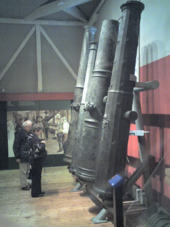Key Point: The culverin is an early modern cannon, developed in the 15th century, characterized by a relatively long barrel and a smaller bore. Its size could vary, but typical culverin cannons had an overall length ranging from 2.4 to 3 meters.
In this article, we will be exploring the Culverin. This remarkable artillery piece, born from a period of rapid technological advancement, forever altered the course of warfare. With its long, slender barrel and enhanced capabilities, the Culverin unleashed a devastating force upon fortifications and enemy formations alike.
So, join me on a journey through history as we uncover the origins, innovations, and impact of this formidable weapon. Before we start things off, here is a short and concise definition of what a Culverin is:
A Culverin is a long-barreled artillery piece that emerged during the 15th century, known for its increased accuracy and range compared to earlier cannons.
Now, let’s move on to the origins of the Culverin.
The Origins Of The Culverin

The Culverin emerged during the 15th century. Its origins can be traced back to the rapid advancements in warfare technology that occurred during the late Middle Ages. It was developed as an improvement upon earlier cannons, so it represented a significant leap forward in artillery design.
The term “culverin” itself is believed to have originated from the Latin word “colubrinus,” meaning “snake-like.” This reference might have something to do with the slender and serpentine shape of the Culverin’s barrel.
Over its time on the battlefield, the Culverin underwent further refinements and modifications. It eventually gave rise to other types of artillery pieces, such as the demi-culverin and the saker. These subsequent developments incorporated improvements in size, range, and projectile capabilities, further shaping the evolution of artillery technology.
Now lets move on and take a look at the physical characteristics of the Culverin …
Description Of The Culverin
The Culverin was a long-barreled cannon, typically made of bronze, with an average length of around 9 to 11 feet.
It was relatively lighter than its predecessor, the Bombard, making it more maneuverable on the battlefield. Which was a big plus. The Culverin’s design also allowed for greater accuracy and increased range, making it a formidable weapon against enemy fortifications and infantry.
Its sleek and streamlined appearance made it an iconic symbol of artillery power during that era.
Now for the projectiles it shot out …
Projectile Caliber Of The Culverin
The Culverin cannon fired solid iron cannonballs. These cannonballs had varying calibers, ranging from approximately 3 to 6 inches in diameter.
The choice of caliber depended on the specific variant of the Culverin and the intended target. The solid iron projectiles, propelled by the explosive force of gunpowder, were capable of inflicting devastating damage to fortifications and enemy forces.
Now, let’s take a closer look at its role in famous battles and its overall impact on the course of events.
Significant Battles And Impact
The Culverin played a crucial part in numerous conflicts across Europe and beyond. It was used extensively in the famous Battle of Pavia in 1525, where the firepower and range of the Culverin contributed to the victory of the Imperial forces over the French army.
The very introduction of the Culverin marked a shift in artillery tactics, with its enhanced capabilities providing greater tactical flexibility and effectiveness on the battlefield.
Disadvantages And Decline
Despite its advancements, the Culverin had a few limitations.
Its long barrel required sturdy carriages and complex mechanisms, making it more expensive to produce and maintain compared to other cannons of the time. Also, the Culverin’s rate of fire was relatively slow due to the time required for reloading and cooling between shots.
These factors, combined with the emergence of newer artillery technologies, eventually led to the decline in the prominence of the Culverin on the battlefield.
This leads us perfectly to the …
Successor To The Culverin
Following the era of the Culverin, cannons such as the Demi-culverin and the Basilisk came into prominence.
These cannons incorporated improvements in design, mobility, and firing rates, building upon the principles established by the Culverin. They represented the next step in the evolution of artillery, shaping the future of warfare.
In Conclusion
Thank you for taking the time to read this article. I hope you learned a thing or two. And I will see you at the next one.
Take care!